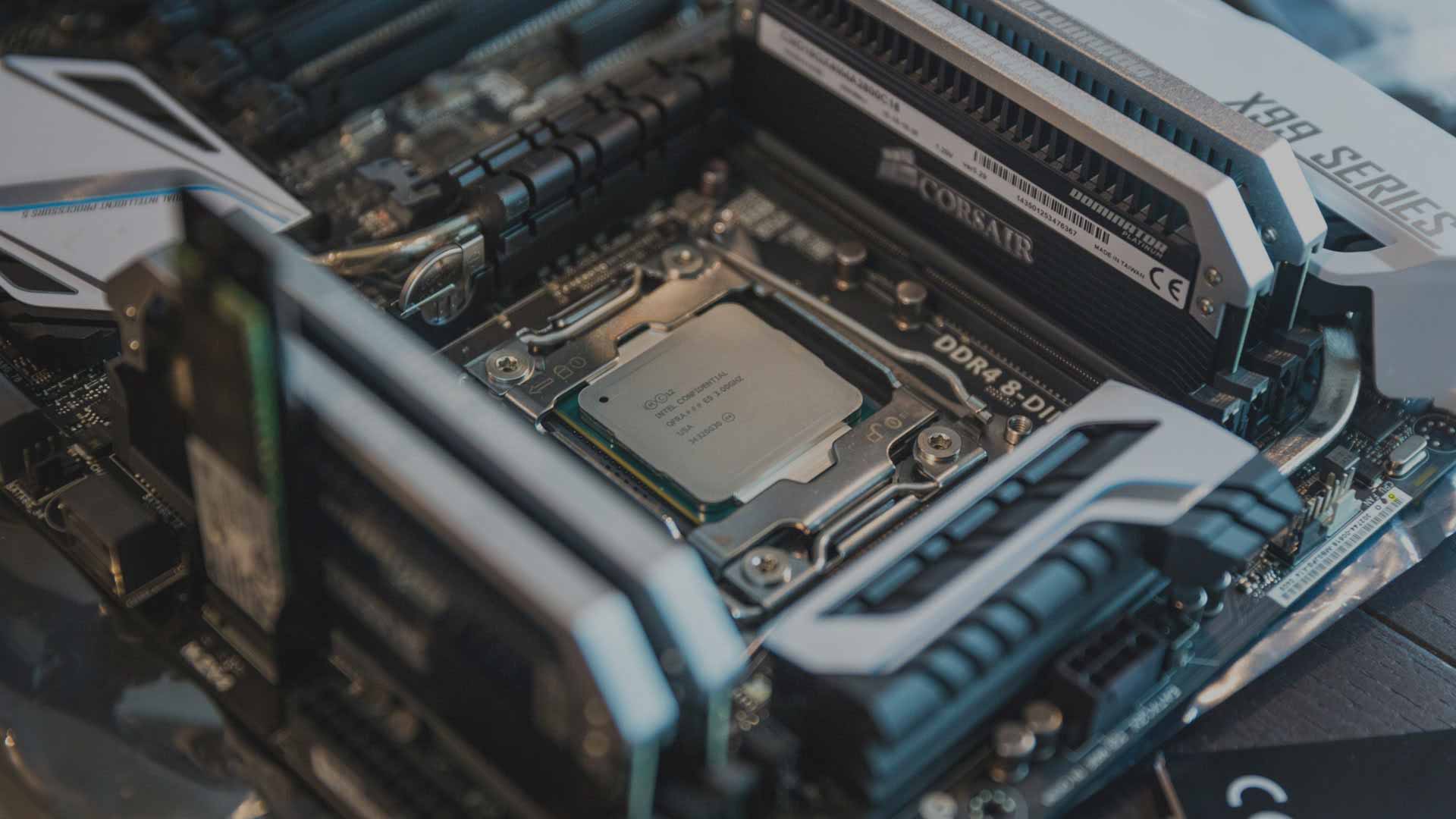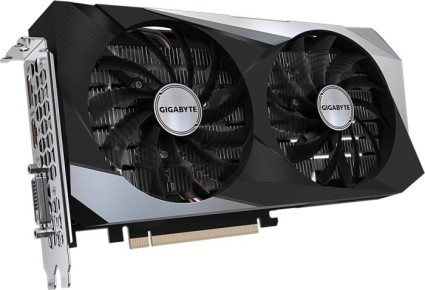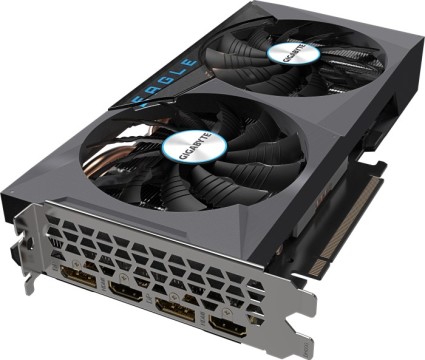
GIGABYTE RTX 3050 Windforce OC 8G vs. GIGABYTE RTX 3060 Eagle OC 12G (Rev. 2.0) (LHR)
In diesem Vergleich von GIGABYTE RTX 3050 Windforce OC 8G versus GIGABYTE RTX 3060 Eagle OC 12G (Rev. 2.0) (LHR) vergleichen wir die technischen Daten der beiden GPUs. Welche Grafikkarte ist schneller? Hier gibt es FPS & Benchmarks in Gaming und Anwendungen. Außerdem Daten zu Verbrauch, Effizienz (FPS pro Watt) und Preis-Leistung (FPS pro Euro).

Allgemeine Informationen
| Günstigster Preis | ||
| Hersteller | GIGABYTE | GIGABYTE |
| Serie | NVIDIA GeForce RTX 3050 - 8GB | NVIDIA GeForce RTX 3060 - 12GB |
| Chip-Architektur | Ampere (ab 2020/Q3) | Ampere (ab 2020/Q3) |
| Chip-Bezeichnung | GA106-150-KA-A1 | GA104-150-KC-A1 |
| Fertigung | Samsung 8 nm | Samsung 8 nm |
| Chip-Größe | 276 mm² | 392 mm² |
| Kühlung | 2x Axial-Lüfter (100mm) mit 0dB-Zero-Fan-Modus | 2x Axial-Lüfter (100mm) mit 0dB-Zero-Fan-Modus |
Spezifikationen
Die Anzahl der Recheneinheiten, die Taktraten sowie die Größe des Cache sind neben der zugrunde liegenden Architektur ein Indiz für die Leistungsfähigkeit eines Produkts. Die GIGABYTE RTX 3050 Windforce OC 8G verfügt über 2560 FP32-ALUs und hat damit deutlich weniger Recheneinheiten als die GIGABYTE RTX 3060 Eagle OC 12G (Rev. 2.0) (LHR) mit 3584 FP32-ALUs. Der Boost-Takt der GIGABYTE RTX 3050 Windforce OC 8G liegt mit 1792 MHz etwas weniger als/wie bei der GIGABYTE RTX 3060 Eagle OC 12G (Rev. 2.0) (LHR) mit 1807 MHz.
| Basis-Takt | 1552 GHz | 1320 GHz |
| Boost-Takt | 1792 GHz | 1807 GHz |
| Übertaktung | +15MHz Boost | +30MHz Boost |
| Chip-Konfiguration | 20SM (2560SP / 80TMU / 32ROP) | 28SM (3584SP / 112TMU / 64ROP) |
| Rechenleistung | 9.18 TFLOPS (FP16), 9.18 TFLOPS (FP32), 0.14 TFLOPS (FP64) | 12.95 TFLOPS (FP16), 12.95 TFLOPS (FP32), 0.2 TFLOPS (FP64) |
Kompatibilität und Abmessungen
| Schnittstelle | PCIe 4.0 x16 (x8) | PCIe 4.0 x16 |
| Abmessung | 243,6 | 242 |
| Gesamthöhe | Dual Slot | Dual Slot |
| Bauform | PCIe-Karte (full height) | PCIe-Karte (full height) |
| Slotblende | full height | full height |
| Leistungsaufnahme (TDP) | 130W | 170W |
| Zusätzliche Stromanschlüsse | 1x 8-Pin PCIe | 1x 8-Pin PCIe |
Speicher
Die GIGABYTE RTX 3050 Windforce OC 8G verfügt über 8 GB GDDR6 Videospeicher, welcher an ein 128 Bit Speicherinterface angebunden ist und mit 14 Gbps taktet. Die Speicherbandbreite liegt damit bei 224 GB/s. Bei der GIGABYTE RTX 3060 Eagle OC 12G (Rev. 2.0) (LHR) sind dagegen 12 GB GDDR6 VRAM mit einer Taktrate von 15 Gbps an einem 192 Bit Speicherinterface angeschlossen. Daraus resultiert eine Speicherbandbreite von 360 GB/s.
| Speicherkapazität | 8 GB | 12 GB |
| Speichertyp | GDDR6 | GDDR6 |
| Speicherinterface | 128 Bit | 192 Bit |
| Speichertakt | 14 Gbps (1750 MHz) | 15 Gbps (1875 MHz) |
| Speicherbandbreite | 224 GB/s | 360 GB/s |
Videoanschlüsse
| HDMI | 1x HDMI 2.1 | 2x HDMI 2.1 |
| DisplayPort | 1x DisplayPort 1.4a | 2x DisplayPort 1.4a |
Transcoding-Engine
| NVENC | 1x (7th Gen, max. Sessions: 5) | 1x (7th Gen, max. Sessions: 8) |
| NVDEC | 1x (5th Gen) | 1x (5th Gen) |
Encoding
| H.265 | ✓ (4K YUV 4:2:0 / 4K YUV 4:4:4 / 4K Lossless / 8K / HEVC 10bit support / HEVC B Frame support) | ✓ (4K YUV 4:2:0 / 4K YUV 4:4:4 / 4K Lossless / 8K / HEVC 10bit support / HEVC B Frame support) |
| H.264 | ✓ (YUV 4:2:0 / YUV 4:4:4 / Lossless) | ✓ (YUV 4:2:0 / YUV 4:4:4 / Lossless) |
Decoding
| AV1 | ✓ (8bit / 10bit) | ✓ (8bit / 10bit) |
| H.265 | ✓ (8bit 4:2:0 / 10bit 4:2:0 / 12bit 4:2:0 / 8bit 4:4:4 / 10bit 4:4:4 / 12bit 4:4:4) | ✓ (8bit 4:2:0 / 10bit 4:2:0 / 12bit 4:2:0 / 8bit 4:4:4 / 10bit 4:4:4 / 12bit 4:4:4) |
| H.264 | ✓ | ✓ |
| VP9 | ✓ (8bit / 10bit / 12bit) | ✓ (8bit / 10bit / 12bit) |
| VP8 | ✓ | ✓ |
| VP8 | ✓ | ✓ |
| VP8 | ✓ | ✓ |
| VP8 | ✓ | ✓ |
API-Unterstützung
| DirectX | 12 Ultimate (12_2) | 12 Ultimate (12_2) |
| CUDA | 8.6 | 8.6 |
| Vulkan | 1.3 | 1.3 |
| OpenCL | 3.0 | 3.0 |
| OpenGL | 4.6 | 4.6 |
| Shader Modell | 6.7 | 6.7 |
| Multi-GPU-Unterstützung | - | - |
Chip-Unterstützungen
| Raytracing | ✓ (2nd Gen NVIDIA RTX) | ✓ (2nd Gen NVIDIA RTX) |
| NVIDIA Tensor | ✓ (3rd Gen) | ✓ (3rd Gen) |
| HDCP | 2.3 | 2.3 |
Sonstiges
| Einführung | 04.01.2022 | 01.09.2021 |
| Herstellergarantie | drei Jahre (ab Produktionsdatum, Abwicklung über Händler) | drei Jahre (ab Produktionsdatum, Abwicklung über Händler) |
Spiele

- NVIDIA GeForce RTX 3060 - 12GBAVG139.50 %1%143.36 %
- NVIDIA GeForce RTX 3050 - 8GBAVG100.00 %1%100.00 %

- NVIDIA GeForce RTX 3060 - 12GBAVG27.7 FPS1%21.2 FPS
- NVIDIA GeForce RTX 3050 - 8GBAVG20.5 FPS1%15.5 FPS

- NVIDIA GeForce RTX 3060 - 12GBAVG75.5 FPS1%42.5 FPS
- NVIDIA GeForce RTX 3050 - 8GBAVG54.4 FPS1%29 FPS

- NVIDIA GeForce RTX 3060 - 12GBAVG301.3 FPS1%185.6 FPS
- NVIDIA GeForce RTX 3050 - 8GBAVG219 FPS1%133.7 FPS

- NVIDIA GeForce RTX 3060 - 12GBAVG48.9 FPS1%41.1 FPS
- NVIDIA GeForce RTX 3050 - 8GBAVG35.1 FPS1%29.4 FPS

- NVIDIA GeForce RTX 3060 - 12GBAVG99.3 FPS1%86.7 FPS
- NVIDIA GeForce RTX 3050 - 8GBAVG72.1 FPS1%61.1 FPS

- NVIDIA GeForce RTX 3060 - 12GBAVG102.9 FPS1%85.1 FPS
- NVIDIA GeForce RTX 3050 - 8GBAVG76.4 FPS1%63.3 FPS

- NVIDIA GeForce RTX 3060 - 12GBAVG74.8 FPS1%50.2 FPS
- NVIDIA GeForce RTX 3050 - 8GBAVG52.4 FPS1%34.1 FPS

- NVIDIA GeForce RTX 3060 - 12GBAVG102.1 FPS1%84.5 FPS
- NVIDIA GeForce RTX 3050 - 8GBAVG69.6 FPS1%60.6 FPS

- NVIDIA GeForce RTX 3060 - 12GBAVG36.6 FPS1%23.9 FPS
- NVIDIA GeForce RTX 3050 - 8GBAVG25.7 FPS1%16.6 FPS

- NVIDIA GeForce RTX 3060 - 12GBAVG117.5 FPS1%84.8 FPS
- NVIDIA GeForce RTX 3050 - 8GBAVG84.6 FPS1%58.2 FPS

- NVIDIA GeForce RTX 3060 - 12GBAVG45.3 FPS1%35.6 FPS
- NVIDIA GeForce RTX 3050 - 8GBAVG33.3 FPS1%22.2 FPS

- NVIDIA GeForce RTX 3060 - 12GBAVG73.9 FPS1%57.1 FPS
- NVIDIA GeForce RTX 3050 - 8GBAVG51.3 FPS1%39.3 FPS

- NVIDIA GeForce RTX 3060 - 12GBAVG0.36 FPSNVIDIA GeForce RTX 3050 - 8GBAVG0.36 FPS

- NVIDIA GeForce RTX 3060 - 12GBAVG0.60 FPSNVIDIA GeForce RTX 3050 - 8GBAVG0.56 FPS
Spiele (RT)

- NVIDIA GeForce RTX 3060 - 12GBAVG158.76 %1%187.18 %
- NVIDIA GeForce RTX 3050 - 8GBAVG100.00 %1%100.00 %

- NVIDIA GeForce RTX 3060 - 12GBAVG19.2 FPS1%15.4 FPS
- NVIDIA GeForce RTX 3050 - 8GBAVG6.6 FPS1%3.3 FPS

- NVIDIA GeForce RTX 3060 - 12GBAVG27.3 FPS1%22.6 FPS
- NVIDIA GeForce RTX 3050 - 8GBAVG20.4 FPS1%16.6 FPS

- NVIDIA GeForce RTX 3060 - 12GBAVG55.9 FPS1%48.1 FPS
- NVIDIA GeForce RTX 3050 - 8GBAVG40.3 FPS1%34.5 FPS

- NVIDIA GeForce RTX 3060 - 12GBAVG82.2 FPS1%69.1 FPS
- NVIDIA GeForce RTX 3050 - 8GBAVG59.8 FPS1%41.2 FPS

- NVIDIA GeForce RTX 3060 - 12GBAVG38.4 FPS1%27.5 FPS
- NVIDIA GeForce RTX 3050 - 8GBAVG27.7 FPS1%19.9 FPS

- NVIDIA GeForce RTX 3060 - 12GBAVG41.5 FPS1%35.3 FPS
- NVIDIA GeForce RTX 3050 - 8GBAVG27.6 FPS1%21.2 FPS

- NVIDIA GeForce RTX 3060 - 12GBAVG33.2 FPS1%23.2 FPS
- NVIDIA GeForce RTX 3050 - 8GBAVG23.6 FPS1%16.3 FPS

- NVIDIA GeForce RTX 3060 - 12GBAVG76.3 FPS1%52.8 FPS
- NVIDIA GeForce RTX 3050 - 8GBAVG54.7 FPS1%37.6 FPS

- NVIDIA GeForce RTX 3060 - 12GBAVG0.18 FPSNVIDIA GeForce RTX 3050 - 8GBAVG0.18 FPS

- NVIDIA GeForce RTX 3060 - 12GBAVG0.30 FPSNVIDIA GeForce RTX 3050 - 8GBAVG0.29 FPS
Produktivität

- NVIDIA GeForce RTX 3060 - 12GBAVG138.71 %NVIDIA GeForce RTX 3050 - 8GBAVG100.00 %

- NVIDIA GeForce RTX 3060 - 12GBPKT68.33 PunkteNVIDIA GeForce RTX 3050 - 8GBPKT47.19 Punkte

- NVIDIA GeForce RTX 3060 - 12GBPKT161.7 PunkteNVIDIA GeForce RTX 3050 - 8GBPKT154.3 Punkte

- NVIDIA GeForce RTX 3060 - 12GBPKT45 PunkteNVIDIA GeForce RTX 3050 - 8GBPKT29 Punkte

- NVIDIA GeForce RTX 3060 - 12GBPKT29.78 PunkteNVIDIA GeForce RTX 3050 - 8GBPKT21.65 Punkte

- NVIDIA GeForce RTX 3060 - 12GBPKT76.39 PunkteNVIDIA GeForce RTX 3050 - 8GBPKT56.97 Punkte

- NVIDIA GeForce RTX 3060 - 12GBPKT77 PunkteNVIDIA GeForce RTX 3050 - 8GBPKT51 Punkte

- NVIDIA GeForce RTX 3060 - 12GBPKT174.27 PunkteNVIDIA GeForce RTX 3050 - 8GBPKT122.68 Punkte

- NVIDIA GeForce RTX 3060 - 12GBPKT86.77 PunkteNVIDIA GeForce RTX 3050 - 8GBPKT61.86 Punkte

- NVIDIA GeForce RTX 3060 - 12GBAVG0.35 FPSNVIDIA GeForce RTX 3050 - 8GBAVG0.37 FPS

